Cliff Swallows are highly belligerent and pugnacious toward others of their own kind, especially when gathering nesting material but almost any time will do.
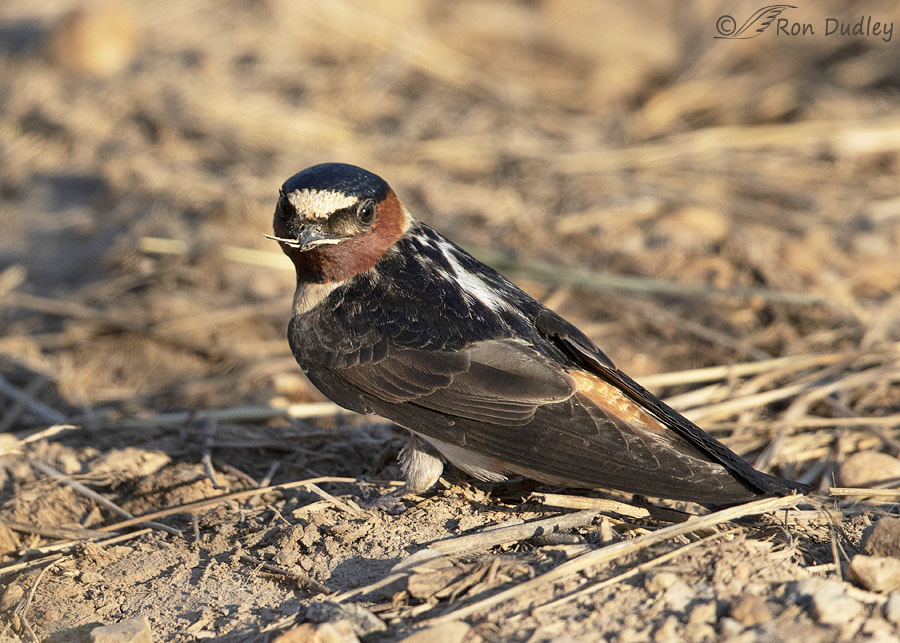
During nesting season I often see large numbers of Cliff Swallows at mudholes gathering mud for nest building but three days ago in the mountains I witnessed a slight variation of the behavior. Instead of gathering mud they were gathering dried grass for their nest linings. There were many dozens of swallows landing in a small patch of dried grass, choosing and picking up pieces of it, and then flying off to their nests.
Typical of Cliff Swallows at mudholes most swallows were raising and fluttering their wings for most of the time they were on the ground as other swallows buzzed all around them before swooping in to do the same thing.
Out of the several hundred photos I took the photo above is one of the very few showing a swallow whose wings aren’t raised and fluttering.
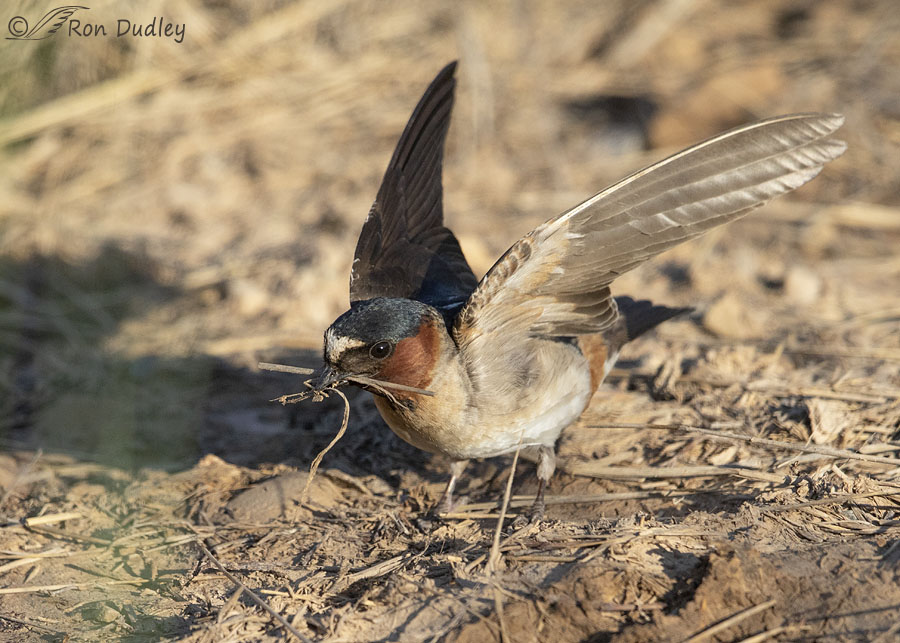
This posture is much more typical of the swallows I photographed that morning.
It’s thought to be a defensive posture used by both sexes and meant to prevent extra-pair copulations (EPCs). At almost any opportunity males try to copulate with swallows other than their own mates and those sexually aggressive males often mistake other males for females. So swallows on the ground, both males and females, typically raise and flutter their wings in an effort to prevent those unwelcome matings while their gathering behavior makes them more vulnerable.
As a result, vicious fights often break out. On this morning I didn’t photograph any fights because I thought I was too close to keep multiple birds in the frame but fights were certainly happening. In hindsight I think it was a mistake to not at least attempt to photograph fighting swallows.
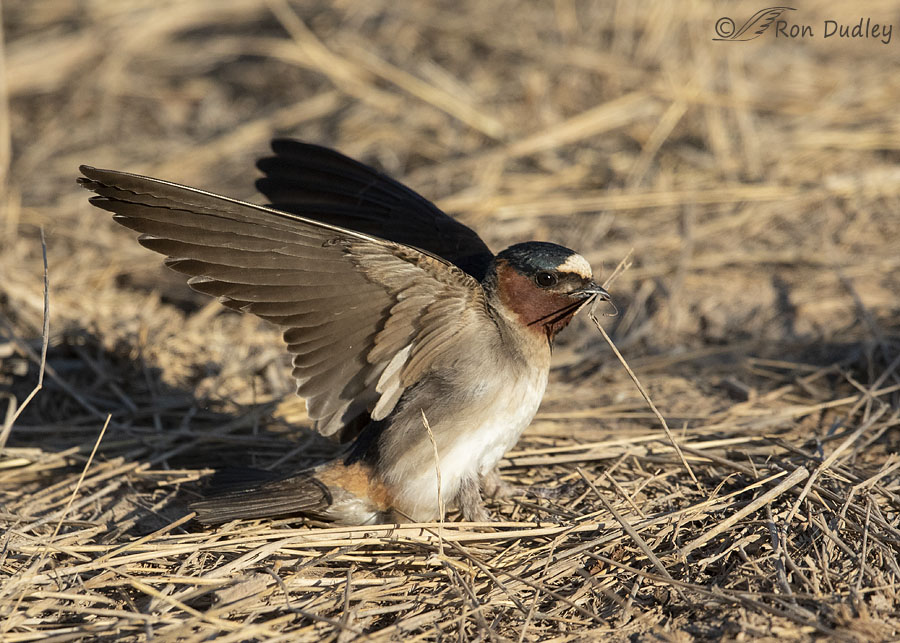
This bird stayed on the ground for an unusually long time as it was gathering grass and its wings were raised and fluttering defensively for almost the entire time. There were so many swallows buzzing around very close to the ground I found it difficult to get photos that didn’t include their shadows. Notice the shadow of another bird on the right side of the frame.
This swallow probably spent more time watching for other aggressive birds than it did gathering grass. Here it had a small bit of nesting material in its bill but eventually…
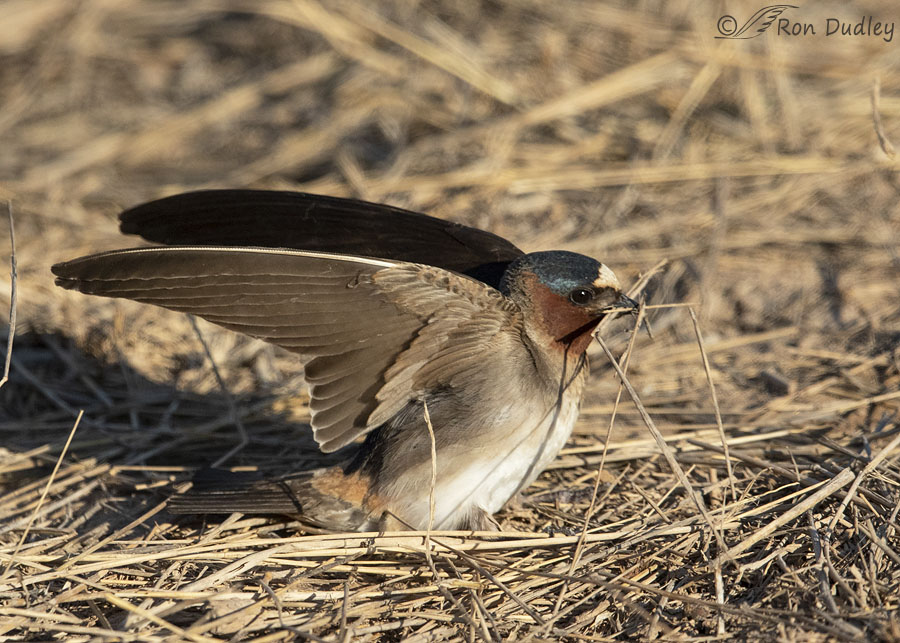
it found a safe opportunity to pick up more grass before it flew off toward its nest.
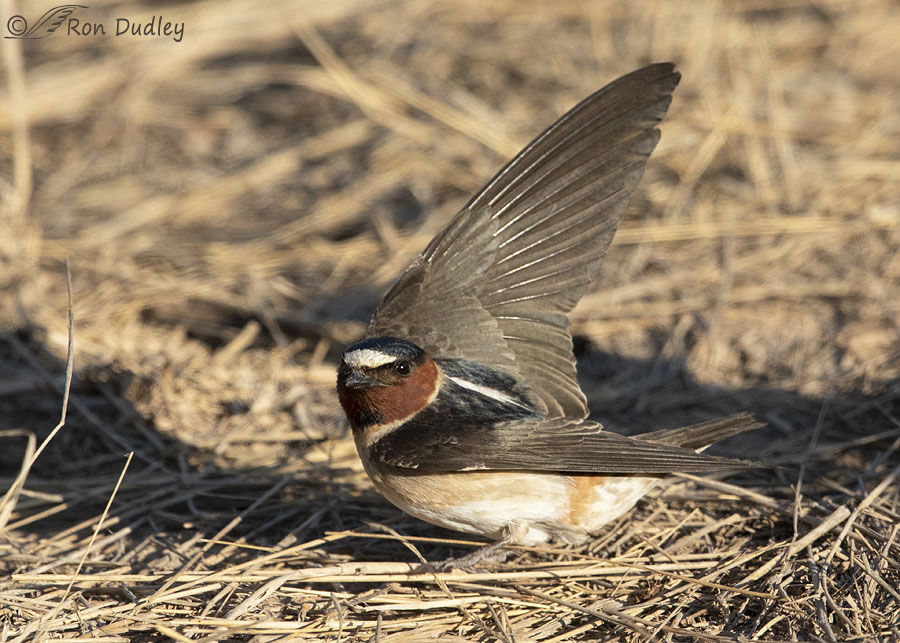
Sometimes they’d raise and flutter only one wing but the intention of the posture was still obvious.
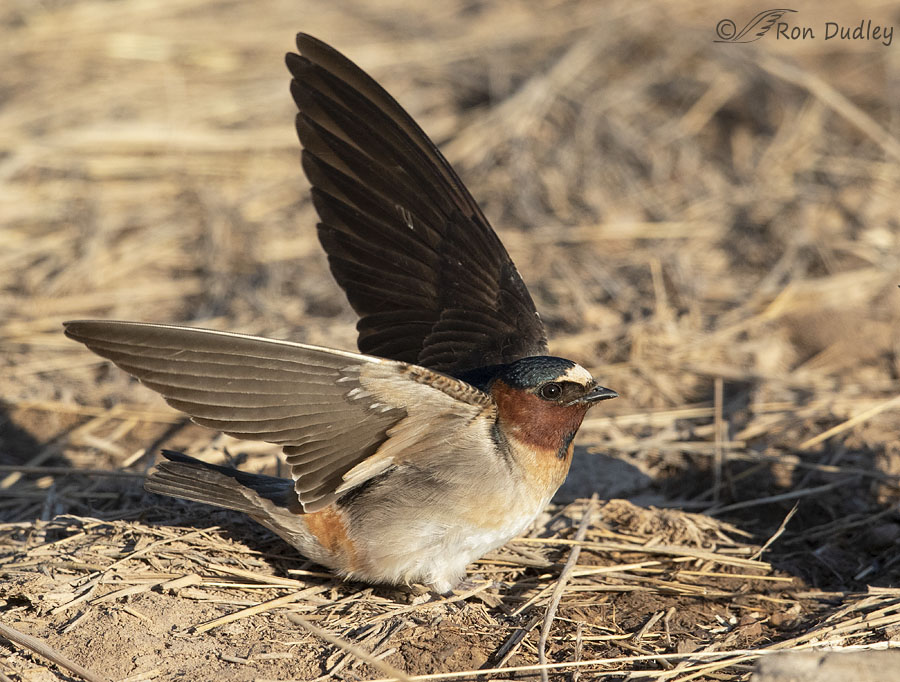
One last photo showing the defensive posture and the shadow of the bird it was directed toward.
I should make it clear that females are sometimes receptive to EPCs and sometimes they aren’t but males always try to reject them. The fights break out whenever the attempted EPCs are unwelcome.
Ron
Note:
If you’re interested in knowing more about EPCs in Cliff Swallows here’s part of what Cornell’s Birds of the World has to say about them.
“Common at mud holes where birds collect mud for nest-building. Also occurs when birds go to the ground to gather grass for nest lining. Both males resident at a colony and nonresident males engage in extra-pair copulations (EPCs) with females. Females sometimes resist, and other times accept EPCs. The number of EPCs per female increases with the size of the mud-gathering group and in larger colonies. When gathering mud, both sexes flutter wings above their back, possibly to prevent being attacked by males seeking EPCs. Other EPCs occur at the colony when a male intrudes into a neighboring nest and forcibly copulates with the female nest-owner. The success of EPCs in leading to fertilizations is unknown, but allozyme exclusion analyses showed that collectively up to 43% of nests in Nebraska contained 1 or more nestlings not related to either the father (EPC) or the mother or both (intraspecific brood parasitism).
A study in Pennsylvania suggested that 13% of nests had extra-pair young and that 5.6% of the total offspring resulted from EPCs. Perhaps as a result of increased rates of EPCs that lead to more intrapair copulations and sperm competition in larger colonies, testis volume increases with colony size. EPCs may be a strategy perpetrated especially by inferior males, because those males had a probability of annual survival about 33% lower than that of males not engaging in EPCs “


EPC – fancy name for bird rape – who knew?! No means no – in this case flapping wings = hell no! Thx for the lesson Ron 🙂
In film days I caught a double decker attempted rape (a.k.a. attempted extrapair copulation) http://stockpix.com/stock/animals/birds/songbirds/swallows/70044.htm
Ron,
Wow. That’s all I got to say. But now I know what they are always flapping their wings at the mud holes! Thanks,
Stephen
I love feedback like yours today, Stephen. It lets me know that my post has been both interesting and informative.
Love the posturing — especially the “wings akimbo.” And DANG — apparently, Cliff Swallows must be the Bonobos of the bird world (and don’t get me started on fish and their sexual proclivities).
Your comparison to Bonobos is pretty darn accurate, Marty.
Without your explanation of their behavior, a viewer might think those birds are just getting ready to take flight (even with a paltry amount of nesting material in beak). Birds have to work very hard to complete their life’s work, from finding the right mate to creating and filling their nest to protecting eggs and raising their brood — amazing to think how many things can interfere with any and all of it and yet they’re still with us. (Though we’re losing far too many; but that’s the human interference, a different story altogether.) Thanks for a very interesting and thoughtful post, Ron!
“we’re losing far too many; but that’s the human interference”
Speaking of that, Chris – have you heard about this new bird die-off? I’ll bet it turns out to be human-caused too.
https://www.nbcnews.com/news/animal-news/scientists-don-t-know-why-hundreds-birds-are-getting-sick-n1271936
Oh boy, I missed that … reminds me of the Pine Siskin die-off in the West earlier this year. Very sad … and yes, I won’t be surprised if it’s found to be related to some human activity. I hope it doesn’t reach our part of the country before someone figures it out.
How absolutely exhausting. And despite all that frantic fluttering EPCs obviously still take place.
Yet another fascinating (and beautifully illustrated) titbit to start my day.
Thank you, EC.
Interesting information. I did not know they had intraspecific brood parasitism.
I watched the swallows at another location along the same stream, it was the first time I had notice them collecting so much dry grass along the stream bank. I tried to get head on photos of them flying back to the nest with full beaks full of grass, but my auto focus is too slow to lock on. I might go back and try with manual focus.
April, swallows in flight are a huge challenge for the photographer no matter the speed of their AF. My AF is fast and I rarely succeed with them.
Fascinating post. I just read most of the BotW account. Looks like Male Cliff Swallows are a step up, so to speak, from yesterday’s House Wren, in that they share equally in nest building and incubation, although males of both species feed the chicks. I’ll leave comparisons to the other two-legged species behavior to others.😁
Thanks, Lyle. Then you spent some time reading, it’s a pretty lengthy account.
So often the education you provide is as excellent as your photos. Thannks, Ron. I’d wondered about the fluttering but not explored the reason.
Thanks, Nancy. The fluttering behavior is kind of strange looking isn’t it.
Wonderful series Ron! Thanks for sharing!
Charlotte
Thanks, Charlotte.
How very interesting. Not a species found around here I think (but I only moved to the east coast 2 yrs ago so there is much I don’t know about this area) so it is very interesting to learn about these behavioursof the birds in your area. And your photos are so clear and sharp they are a joy in themselves. Thanks for taking the time to entertain us with these tidbits of species info.
Good to know you appreciate the sharpness of these photos, Pat. I wish all of mine were that sharp.
Sex even while working. Excellent series Ron. Photos are super and the education is well worth the reading. Once again you come through with a dual purpose posting.
Recently I have been watching the Mourning Dove copulation activities out back and it very much resembles the activities of the Mallards in the water. I am consistently seeing two male doves following a female everywhere she goes jumping up to mount her and 99% of the time failing to do so. I have seen them go all the way across the yard on top of the fence and sometimes even into one of the bird baths while trying to complete the task with zero cooperation from the female.
Thanks, Everett. Sounds like female doves playing hard to get.
Very interesting and enjoyable photos! I’ve caught swallows at a mud hole at the corner of a road at the marsh I frequent. The wing fluttering is astounding. A combination of their coloring, movement, sunshine and shadows has always made getting good photographs a challenge. Many times I just sit and enjoy the activity.
Kathy, it can be a difficult behavior to photograph well but it’s always fun to try.
So– “intraspecific brood parasitism”– does that mean that another female
nighthawk sneaks in and lays 1 or more eggs in a nest usually occupied by
another female nighthawk and its eggs ? Like cowbirds ?
Kris, here’s the definition:
“Intraspecific brood parasitism involves laying eggs in the nest of another individual of the same species without subsequently caring for the eggs or hatchlings”
Nice shots, Ron. Interesting behavior I hadn’t paid much attention to! Mud gathering seems to be done here – on to sitting on the power line across the creek waiting for a “bug rise”. 🙂 Then to compete with the Nighthawks…
“Out of season” the Cottonwood trees are just now putting out cotton….😲
Thanks, Judy. Males often attempt EPCs even when the birds are perched on power lines, you might want to watch for it.